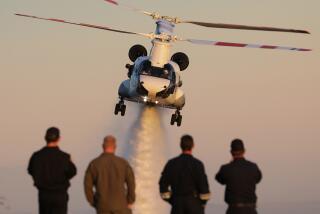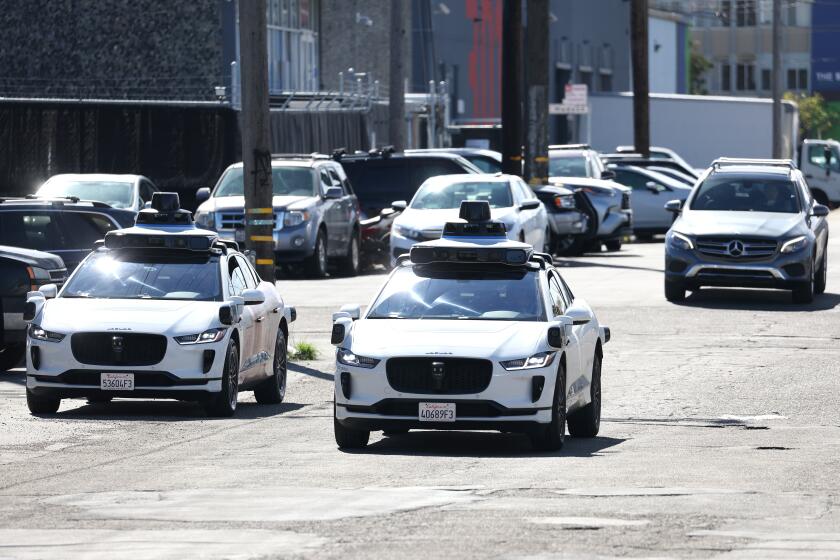FAA Plans to Put Air Traffic Control on New Flight Path
- Share via
WASHINGTON — The Federal Aviation Administration is developing a revolutionary system of air traffic control that would replace aging radar, radio and computer equipment that has been breaking down with increasing frequency, sometimes leaving pilots groping for guidance.
The new system would employ satellites 11,000 miles above the Earth, sophisticated collision-avoidance gear in planes and data-link communications on the ground to keep aircraft safely apart in flight, allowing the FAA to scrap cumbersome, expensive and increasingly unreliable electronic gear that in some cases dates back to the 1950s.
But the most audacious part of the new concept would change who is responsible for keeping jetliners, private planes and military aircraft from bumping into one another as they hurtle through America’s increasingly crowded skies.
The FAA, which employs 17,146 civilian air traffic control personnel at more than 650 facilities throughout the nation, wants to strip the controllers of the primary aircraft-separation responsibility during long-distance flights, giving that chore to the pilots.
“It’s a revolution in the way we handle air traffic control,” said George Donohue, an FAA associate administrator responsible for the development of technologies. “The pilots are better judges of what’s safe than the controllers, because if a pilot fouls up, he’s dead.” But there are a couple of problems: The pilots say they don’t want primary responsibility for aircraft separation, and the controllers say they want to keep it.
Not only that, the Air Line Pilots Assn., which represents about 43,000 commercial airline pilots, and the National Air Traffic Controllers Assn., representing 70% of the controllers, say switching the air traffic responsibilities to the pilots--already burdened with the demanding tasks of flying complex jetliners--may not work.
Some federal officials privately agree.
“If they ever try it, it’s just going to be one hell of a mess out there,” said a senior federal air safety official, speaking under a guarantee of anonymity. “With all those pilots up there, there has to be a referee to keep them apart. And that referee has to be the air traffic controller on the ground.”
Despite the controversy, pilots, controllers, FAA bosses and air safety officials are in agreement on one thing: The current air traffic control system is in serious need of a major overhaul.
Faltering Equipment
During the past year, long-range radar equipment used to guide jetliners cruising at high altitudes over the United States has faltered or failed completely a dozen times, including a failure last week in Illinois, often because of stuttering computer gear that dates back 25 years or more.
Newer systems, including a radar called the ASR-9 that was developed in 1989 to guide planes as they approach the nation’s busiest airports, have been equally troubled. An ASR-9 at Huntsville, Ala., suffered 42 outages from 1990 to 1993, and two others in southern Florida went down 29 times in June and July this year, according to published reports.
Fortunately, backup systems usually provided controllers with some form of radar coverage. But in some cases, power blackouts that switched off radar units without a working backup also knocked out radio communication.
When that happened a month ago in Northern California, controllers on the ground were rendered deaf, mute and blind. There were established procedures to follow in such circumstances. Pilots switched to other radio frequencies and talked to other air traffic control facilities, reporting where they were and where they were heading. Automated collision-avoidance systems already installed in many of the jetliners warned of the approach of any other aircraft.
No planes crashed, and few, if any, had to take evasive action to avoid other aircraft.
But the incidents tied up several of the nation’s already congested air travel hubs and provided grim reminders of the fragility of an air traffic control system that is rapidly becoming outdated.
“The FAA has been delinquent in replacing its air traffic control equipment,” Donohue acknowledged, noting that some of the agency’s oldest communications gear--dating back to the technologies of World War II--still uses vacuum tubes like those in the radios on which Americans listened to “Fibber McGee and Molly.”
FAA’s Problems
Donohue blames much of the problem on current budget struggles and a bureaucratic procurement system lacking the efficiencies and economies of private enterprise.
Mike Connor, director of safety and technology for the National Air Traffic Controllers Assn. and John E. O’Brien, director of engineering and safety for the Air Line Pilots Assn., blame the FAA’s revolving-door leadership, in which presidentially-appointed administrators have changed six times in the past 14 years.
Whatever the reasons, the FAA has struggled with modernization programs that have bogged down and been scrapped several times in recent decades, while countries such as Britain and Germany have purchased and installed air traffic control equipment more sophisticated than that used by the FAA--equipment that in many cases was developed here in the United States.
The FAA’s difficulties with aging equipment are compounded by personnel problems.
Over the last five years, attrition, buyouts and retirements have trimmed the FAA work force by about 5,000 jobs--to a total of about 48,000--even as the number of electronic systems to maintain and the number of aircraft to control have increased.
“Because of budget cuts, I haven’t been able to hire anyone for a long time,” Donohue said.
Mike McNally, executive vice president of the controllers union, said the increasing workload brought on by burgeoning air traffic and the FAA’s inability to hire new people has reduced morale “to the lowest it’s ever been.”
Donohue said there are similar problems for the FAA technicians who maintain and repair the electronic gear.
“It’s not a real happy work force--old equipment, austere budgets, often no raises and Congress talks about reducing retirement benefits,” Donohue said.
But despite all these problems, the FAA, the controllers and the pilots all insist that this nation’s current air traffic control system is good--probably still the best in the world--with a reliability rating of well over 99%.
“Is it safe? Yes,” O’Brien said. “Could it be safer? Certainly.”
To that end, Donohue and others at the FAA are working on short-, medium- and long-term fixes that they believe will make America’s the most advanced system on Earth.
Replacement Program
The five stuttering computers that caused most of the radar problems at the centers providing long-range guidance for high-altitude flights are being replaced under a short-term, stopgap program announced last month by FAA chief David Hinson.
The old computers originally had been scheduled for replacement about three years ago, but--in a foul-up typical of the difficulties encountered by the FAA in its repeatedly reworked modernization plans--the software for those replacements wasn’t ready on time.
The FAA says the stopgap replacements announced by Hinson will be ready in 1997, just two years before a medium-range fix involving still another computer goes on line across the nation.
Short- and medium-term fixes for the ASR-9 radar systems also are in the works, the FAA said.
But all of these would be rendered largely obsolete if the FAA succeeds in developing its entirely new air traffic control concept, known as Free Flight.
At present, jetliners are directed by air traffic controllers along “airways” that are, in effect, roadways in the sky.
Jetliners currently proceed, one behind the other, along these airways, which are precisely drawn on the navigation charts used by all pilots. Any deviations--necessitated in most cases by bad weather--must be approved by the air traffic controllers.
Airways make it relatively easy for controllers to keep track of exactly where jetliners are and to maintain an adequate distance between them.
Airway Drawbacks
But there are disadvantages.
By following airways instead of straight-line routes, jetliners burn extra fuel. Air traffic is increasing--experts say it could jump another 50% or more in the next 10 years--and on many routes, the airways are getting overcrowded. Overcrowding causes delays, which burn more fuel. All this extra fuel costs airlines hundreds of millions of dollars a year, industry experts say.
The radar systems that make the current air traffic control system possible have their drawbacks too. Radar units--big, bulky and mechanically complex--are expensive to build, expensive to maintain, expensive to fix and expensive to protect from the weather. Buildings, mountains and other obstacles can block their view.
To do away with all these disadvantages, the FAA is proposing Free Flight, under which a pilot would fly the most direct route to his destination, detouring around weather at his own discretion, without guidance from air traffic controllers using radar. Under the concept, the pilot could use most of a three-dimensional chunk of airspace, instead of just the narrow roadways that the FAA has drawn through it.
To accomplish this, the pilot must have a surveillance system on board that is just as accurate--or more so--than the radar on the ground, along with a very precise navigation system. In addition, he must have an on-board system that warns him if he’s getting too close to another plane--preferably one that automatically detours him around the danger. Ideally, a data-link system would relay his position to observers on the ground, and on-board radar would show the weather ahead.
It may sound far-fetched, but a lot of the technology for these systems already exists.
The key to it all is the Global Positioning System, which uses a collection of 24 satellites orbiting in space. The system--originally developed by the U.S. military--is capable of fixing the precise position of any plane--or boat, or car, or person with a small and affordable transmitter receiver unit--anywhere on Earth.
The principle is simple--the transmitter signals three or more of the satellites, which beam back to the receiver. By triangulation, a computer in the unit calculates the position of the user.
Unlike radar, the system is unaffected by weather. Because the satellites are overhead, there is little problem with obstacles.
A second component of the Free Flight equipment is an on-board computerized radar system that warns pilots when they are on a collision course with another plane. Currently installed in most jetliners, these systems are being upgraded to tell the pilot several course changes he can safely make to detour around the danger.
A third component is on-board weather radar, another system already installed on most jetliners. The fourth would be a data-link system--already in the final stages of development--that can transmit all this information to facilities on the ground.
A fifth component would be a ground-based, computerized “conflict probe.” The probe, now under development, would use the information from the data link to predict possible traffic conflicts before the on-board radar can spot them, then work out the best way to avoid them.
New Course
Under the concept envisioned by the FAA, air traffic controllers would still guide planes as they taxi, take off and maneuver through the congested airspace near airports. Pilots would take over as the planes climb to cruise altitudes, retaining primary responsibility for avoiding other aircraft until their planes descend, land and taxi to the terminal.
The FAA is already taking its first small steps toward implementing the Free Flight concept, reducing the routing restrictions on high-altitude flight, starting at 39,000 feet and gradually working down from there. Thus far, the FAA says, there have been no problems.
“But what they want to do--eventually take the whole thing away from the controllers and give it to the pilots--I just don’t see how they can do it,” said the federal air safety official who asked not to be named. “The Free Flight concept is so revolutionary, I can’t see it ever working. Theory and implementation are two different things.”
O’Brien of the pilots union offered a similar view.
“We have a very strong position that the ultimate responsibility for separation of aircraft remains on the ground,” he said. “There will always be a task that has to be sorted out on the ground.”
While not as firm in his opposition, Connor of the controllers union still had strong reservations.
“While the concept should be explored, that must be done carefully, gradually,” he said. “The workload on pilots is still too great for them to have primary responsibility for separation.”
But the FAA’s Donohue disagrees.
“I think Free Flight will work,” he said. “Of course, right now, there’s some reluctance to change on the part of the players, but that’s human nature. . . .
“There’s some hesitancy by pilots to accept responsibility for separation. But a pilot has ultimate responsibility for the safety of his aircraft right now.”
Donohue said that in the increasingly automated cockpits, pilots seem to have more than adequate time to handle their responsibilities, and could accept more.
FAA officials say--only half-jokingly--that the increased automation works so well that at some point, only a single pilot and a dog would remain in the cockpit.
“The pilot would be there to feed the dog,” said Bill Mosely, an FAA air traffic control specialist. “The dog would be there to bite the pilot if he touches anything.”
(BEGIN TEXT OF INFOBOX / INFOGRAPHIC)
‘Free Flight’
Under the current system, pilots follow radar-monitored routing, almost like highways in the sky. (Zigzag pattern shown below is exaggerated for effect). Under the new system, pilots would be free to choose more direct routes.
HOW NEW SYSTEM MIGHT WORK
1) Air traffic controllers using radar guide pilot at takeoff.
2) Once away from airport, pilot selects route. Flight would be guided by satellites.
3) Computerized conflict probe on ground detects another plane in its path. It offers pilot, via data link, several alternative detours. If pilot get too close to a plane, on-board radar would sound warning.
4) On-board weather radar shows huge thunderstorm ahead. Pilot is free to detour around storm without alerting air controllers.
5) As plane nears airport, air controllers resume guiding plane, just as under the current system.
More to Read
Inside the business of entertainment
The Wide Shot brings you news, analysis and insights on everything from streaming wars to production — and what it all means for the future.
You may occasionally receive promotional content from the Los Angeles Times.










